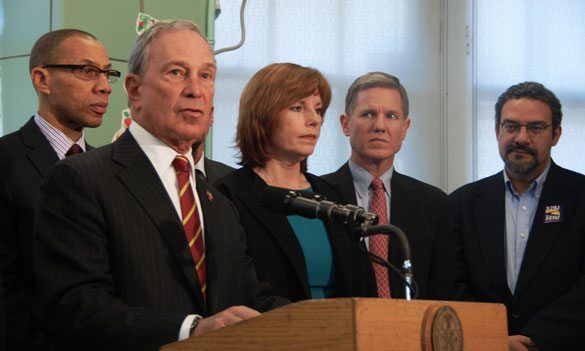Bloomberg Gives Glimpse Of New Building Requirements In Flood Prone Areas

Some lame duck politicians go out on a whimper, defeated by gridlock, apathy and restlessness on part of the people. Mayor Michael Bloomberg is not one of those politicians. In just the past few months alone, Bloomberg has pushed a massive $20 billion storm protection plan and scored a victory when the New York State Supreme Court upheld his plan to expand taxi service across the city. He’s expanding recycling programs, banning styrofoam, and even pissing off Sarah Palin. The New York Times is now reporting that Bloomberg is seeking to make major changes to the city’s building code to increase the resiliency of buildings citywide in the event of more extreme weather incidents like Superstorm Sandy.
Needing only the approval of the City Council, Bloomberg’s plan to overhaul the building code would make New York City a national leader in making buildings more resilient in the face of hurricanes. For the time being, the new rules would mainly affect the construction of new buildings and big renovations on existing buildings in the flood areas, including much of Sheepshead Bay.
But some upgrades could also be required in existing larger buildings. The Times listed changes that would have to made to residential buildings, co-ops, condominiums, public housing and rental apartments:
For example, emergency lights will be required in hallways and stairwells in case of extended blackouts. Existing buildings will have to add faucets to a common area on lower floors, like a laundry room. That is intended to allow people on upper floors, which lose water pressure from electric pumps during blackouts, to obtain water.
Officials and experts estimated that a 20-story co-op could spend $16,000 for faucets in a laundry room, and more than $100,000 for backup lighting that could last many days. The lighting would be far cheaper if owners deployed battery-powered lights with a shorter life.
Bloomberg’s task force, which he set up with Council Speaker Christine Quinn, did not propose any new rules for existing single-family homes. Still, homeowners looking to make major renovations would have to conform to new regulations like using longer screws and nail fasteners on windows and doors so they can stand up to high winds. New sloped roofs would have to use reflective shingles to cut down on heat.
Hospitals would also have to protect their windows, potentially costing them hundreds of thousands of dollars per building. The city also wants to force businesses that store toxic chemicals to keep them in flood-proof areas. Resistance to the plan is expected to come from real estate developers who fear the overall increased costs they would incur.
In pushing the changes, Bloomberg cited the destruction of Sandy as an imperative.
“Sandy clearly underscored why we need to protect our buildings. We learned a lot, and we want to make sure we won’t forget those lessons,” the mayor said at a press conference.
Mayoral front-runner Christine Quinn stressed speed as being an important factor in executing Bloomberg’s plan.
“We plan to move as quickly as possible,” Quinn told the Times.